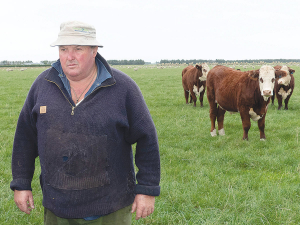Move over ham, here comes lamb
It’s official, lamb will take centre stage on Kiwi Christmas tables this year.
 Mark Copland with Simmental-cross animals on his sheep and beef farm near Ashburton. Photo: Rural News Group.
Mark Copland with Simmental-cross animals on his sheep and beef farm near Ashburton. Photo: Rural News Group.
Superior weight gain makes Simmentals the breed of choice for Canterbury sheep and beef farmer Mark Copland.
His father first brought Simmental calves onto the 670ha family farm Westmere, near Chertsey, just north of Ashburton.
“They were bloody good,” says Copland (prn Copeland). “They are a great breed to mix with Hereford and are fast growing.”
As a finishing farmer, Copland does no cattle breeding but always buys Simmental cross for finishing when he can get them. It is a good breed for finishing, he says.
“The Simmental lays down a lot more meat with that first cross. And you get hybrid vigor; that’s pretty handy.”
Copland says first-cross Simmental Hereford would be the breed of choice if they were to breed their own.
“Herefords produced today are high quality and with our Simmental/Hereford mix we are in a strong position for the future.”
The perceived temperament problems of Simmentals had never been an issue, he says. “Any breed has its ‘unruly children’ and I’ve never found them a problem.”
Arriving on the farm freshly weaned they are kept in holding pens and quickly get used to human contact. “By the end of the second week they’re following you around.”
“They are also easy on the land. You could say they reach the finish line quicker.”
Copland’s preference has recently been vindicated by the Beef + Lamb New Zealand beef progeny trials NZ-wide in which Simmentals showed better weight gains than Angus, Hereford and Charolais.
“It confirmed what was suspected with regard to estimated breeding values (EBVs). EBVs work; they deliver what they predict,” said BLNZ Genetics general manager Graham Alder.
“Simmental bulls produced progeny with a 6kg higher average weaning weight and 20kg higher yearling weight. The actual yearling weights for Simmental ranged between 310kg-340kg versus 285kg-315kg for Angus and 280kg-310kg for Hereford.”
Lower fire risk
Copland farms on the land he grew up on, settled by his grandfather in the early 1900s.
It was run as a dryland sheep farm until bore irrigation went in 15 years ago.
The family is also well-known for breeding and showing Border Leicester sheep and the farm is carrying 2500 breeding ewes.
They also grow barley and peas for seed, share-farmed process potatoes and some fodder beet for wintering.
Last year Copland wintered 1170 beef cattle, 600 r2s and the rest R1s. About 250 18-month-old animals left over from last winter will soon go to the works and he has just started buying R2s for this winter. He also likes to buy at the front end of the calf market.
“There are enough dairy farms around here without us trying to breed them; we’ve got dairy farms on two sides of us.”
Copland says the biggest change he has seen over the years is the rise of green belts from irrigation that have vastly reduced the fire risk on the Canterbury Plains. “My grandfather would tell us stories of the steam trains igniting fires all along the railway line; and sometimes those fires went to the beach.”
Like all his neighbours, his grandfather would drop whatever he was doing to fight any fire. “And a lot of people did that; it was all hands on deck.”
A New Zealand-first native tree study has highlighted the Bioeconomy Science Institute's position as a forestry research leader.
Hemp fibre processor Rubisco is relocating its core processing facility to Ashburton as part of a $20-$30 million expansion to leverage what it says is an accelerating global demand for sustainable and renewable fibres.
Tradition meets some of the latest in technology at the 2026 East Coast Farming Expo.
OPINION: Trade Minister Todd McClay and the trade negotiator in government have presented Kiwis with an amazing gift for 2026 - a long awaited and critical free trade deal with India.
Former Agriculture Minister Nathan Guy says he's excited about his new role as NZ's Special Agricultural Trade Envoy.
A pillar of New Zealand's horticultural industry, Dr Stuart Davis, was farewelled at a well-attended funeral service in Tuakau, South Auckland, on December 18.

OPINION: If the hand-wringing, cravat and bow-tie wearing commentariat of a left-leaning persuasion had any influence on global markets, we'd…
OPINION: With Winston Peters playing politics with the PM's Indian FTA, all eyes will be on Labour who have the…